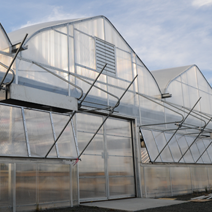Biomass Heating : An Energy Alternative for Commercial Greenhouses
There is a current trend that has caused more and more commercial greenhouse growers to switch their oil and propane powered boilers to biomass systems. The factors that are leading to such changes are simple: in areas where natural gas is not accessible, the options of oil, propane or electricity to heat a commercial greenhouse are becoming far too expensive, in some cases there is a biomass supply close to the greenhouse location, and there has been growing government incentive toward sustainability.

There are factors that greatly affect a biomass system however, which growers must be aware of. The most important factor is the type of fuel intended to be consumed and the quality of this fuel. Currently there are two main biomass fuels being used in North America: wood pellets and wood chips. Wood pellets are basically made from compacted sawdust or other wastes from sawmills and are considered the most efficient fuel for biomass boiler systems. The water content is very low (usually 10%-20%), and it makes for a very efficient use of a renewable fuel source. Wood chips on the other hand can have varying levels of quality as the water content can be as high as 50% and up. Water content plays a huge role in the efficiency of the biomass system. As the water content rises, the burning efficiency diminishes. Another factor that water content affects is the size of storage facility required for the fuel. Fuel with high water content burns less efficiently, thus increasing the quantity needed to get a wood-fired boiler to temperature. The rule of thumb is that a facility using a biomass boiler system would need 7 days of reserve on site, the more efficient fuel with the lower water content would require less tonnage on site. Biomass boiler manufacturers report that most complaints around poor boiler performance are a result of poor quality fuel.

In a biomass system, the fuel type also influences the boiler design as well. All of these systems are customized to the grower’s needs and conditions in order to fully utilize the advantages of the biomass concept: auger sizing, types of screening used, burn capabilities and most importantly the size of the boiler required. Biomass boiler system manufacturers generally size the units to 60% of the total capacity needed to heat the greenhouse in question. A buffer tank for hot water storage is always used for complementing the boiler as well as backup boilers using other available fuel. The concern is not to oversize the boiler as there is a need for running periods that are long and consistent - a wood-fired boiler does not react well when it is constantly modulating or turning off and on after short bursts. In fact, a biomass boiler generally takes approximately 20 minutes to reach required heating temperature, time that a greenhouse would not have in below freezing conditions.
Maintenance has always been an issue with biomass boiler systems, but if quality fuel is used and the boiler is properly set up to burn at its maximum efficiency, the maintenance time can be minimized. Quality fuel means less ash content and extended periods before manual cleaning is necessary. There are biomass boilers on the market that have automatic cleaning techniques using compressed air that can double the time between maintenance schedules.
If you require an outbuilding to store your biomass fuel, check out Tasco Dome.








